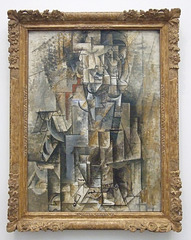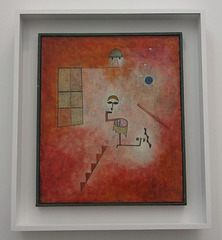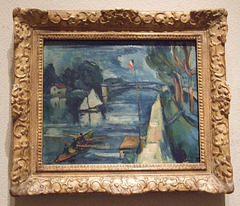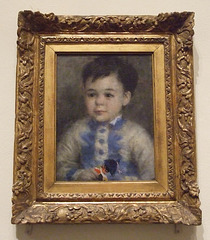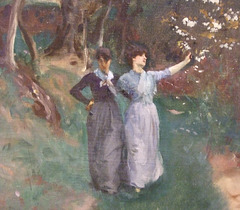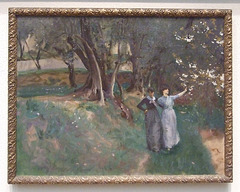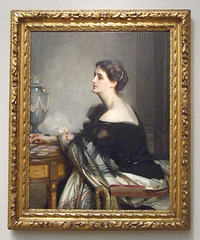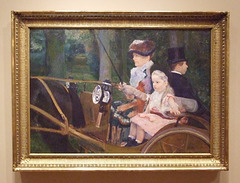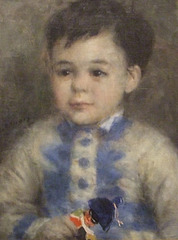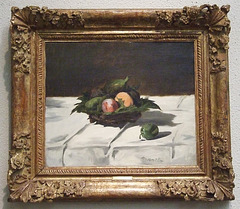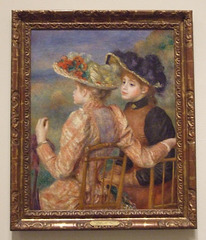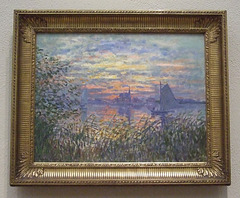
Philadelphia Museum of Art
Man with a Violin by Picasso in the Philadelphia M…
| |
|
Man with a Violin
Pablo Ruiz y Picasso, Spanish, 1881 - 1973
Geography: Made in France, Europe
Date: 1911-12
Medium: Oil on canvas
Dimensions: 39 3/8 x 28 13/16 inches (100 x 73.2 cm)
Copyright: © Estate of Pablo Picasso / Artists Rights Society (ARS), New York
Curatorial Department: Modern Art
Object Location: Currently not on view
Accession Number: 1950-134-168
Credit Line: The Louise and Walter Arensberg Collection, 1950
Label:
A tall, pyramidal form at the center of this painting evokes a human presence, with clues suggesting hair, a moustache, and ears. Two F-shaped sound holes are the only signs of a violin, and scroll-like shapes at the bottom left suggest the arm of a chair. The painting dates from the spring or summer of 1912, a period in the evolution of Cubism often described as hermetic because the subjects appear to be sealed off from recognizable reality.
Additional information:
Publication- Masterpieces from the Philadelphia Museum of Art: Impressionism and Modern Art
Writing about Picasso, the painter and writer Jean Metzinger remarked: "Whether it be a face or a fruit he is painting, the total image radiates in time; the picture is no longer a dead portion of space."1 Man with a Violin, a potent illustration of this assessment, is a prime example of Analytic Cubism, the approach developed by Picasso and Georges Braque beginning in 1909. Instead of creating a likeness of the figure through the use of linear perspective and three-dimensional modeling, Picasso depicted the gentleman not as he would be seen at a given moment, but as he would appear at various times from different positions in space (behind, in front, and to the side). Man with a Violin cannot, then, be compared to the outward appearance of anything already known or seen, but instead creates a reality according to its own cumulative logic of seeing. While it is difficult to determine the painting's subject at first glance, Picasso left several clues to assist us: an ear, a moustache, lips holding a white cylinder (perhaps a cigarette?), and the F-shaped sound holes of a violin. Cubist paintings such as this would influence artists working in an abstract manner, but Picasso's anthropomorphic hints reveal that he was more interested in reinventing representation than in pursuing pure abstraction. Melissa Kerr, from Masterpieces from the Philadelphia Museum of Art: Impressionism and Modern Art (2007), p. 116.
Note:
1) Jean Metzinger, "Note on Painting," as translated in Art in Theory, 1900-1900: An Anthology of Changing Ideas, ed. Charles Harrison and Paul Woods (Oxford and Cambridge: Blackwell Publishers, 1993), p. 178.
Publication- Twentieth-Century Painting and Sculpture in the Philadelphia Museum of Art
Between 1907 and 1914 Picasso's art evolved as if it were a secret language being invented in private conversation with his close collaborator Georges Braque. Man with a Violin reflects the state of their nearly day-to-day interchange in 1912, a time when their styles became almost indistinguishable, based on a shared vocabulary of gridlike scaffolding, overlapping planes, and a palette of ocher, white, and gray. As Braque and Picasso gauged how their paintings evolved, and sometimes even jockeyed competitively to innovate new methods, the two never veered from the rigorously disciplined but intuitive approach that led them to create such focused series of works.
Man with a Violin dates from the spring or summer of 1912, a period in the evolution of Cubism often described as hermetic, as the connection between what appears in Braque's and Picasso's paintings and objects recognizable in nature is almost completely severed. This picture cannot be compared to the outward appearance of anything already known or seen, but instead creates a reality according to its own logic of seeing and reading. Immediately eye-catching and absorbing, its interwoven, shimmering facets and semitransparent planes juxtapose a skeletal, linear structure and transform the receding grid of perspectival space into a flat pattern. A monumental pyramidal form evokes a human presence, while other clues suggest strands of hair, a moustache, and ears. Two F-shaped sound holes are the only signs of a violin, and scroll-like shapes at the bottom left suggest the arm of a chair. Paintings such as Man with a Violin paved the way for much abstract art to come, but Picasso's persistent inclusion of abbreviated signs for human physiognomy and objects shows what all his subsequent work confirms: he was more interested in dissecting and reinventing representation than in pursuing pure abstraction. Philadelphia Museum of Art: Twentieth Century Painting and Sculpture in the Philadelphia Museum of Art (2000), p. 26.
Text from: www.philamuseum.org/collections/permanent/51089.html?mulR=1185637322|2
Prestidigitator by Klee in the Philadelphia Museum…
| |
|
The Seine at Chatou by Vlaminck in the Philadelphi…
| |
|
The Seine at Châtou
Maurice de Vlaminck, French, 1876 - 1958
Geography: Made in France, Europe
Date: c. 1908
Medium: Oil on panel
Dimensions: 14 1/2 x 18 1/4 inches (36.8 x 46.3 cm)
Copyright: © Artists Rights Society (ARS), New York / ADAGP, Paris
Curatorial Department: Modern Art
Object Location: Currently not on view
Accession Number: 1944-12-3
Credit Line: A. E. Gallatin Collection, 1944
Text from: www.philamuseum.org/collections/permanent/48673.html?mulR=1466877634|1
Boy with a Toy Soldier by Renoir in the Philadelph…
| |
|
Boy with a Toy Soldier (Portrait of Jean de La Pommeraye)
Pierre-Auguste Renoir, French, 1841 - 1919
Geography: Made in France, Europe
Date: c. 1875
Medium: Oil on canvas
Dimensions: 13 15/16 x 10 5/8 inches (35.4 x 27 cm)
Curatorial Department: European Painting before 1900, Johnson Collection
Object Location: Gallery 161, European Art 1850-1900, first floor (Annenberg Galleries; Resnick Rotunda)
Accession Number: 1963-116-14
Credit Line: The Mr. and Mrs. Carroll S. Tyson, Jr., Collection, 1963
Text from: www.philamuseum.org/collections/permanent/59197.html?mulR=711803040|1
Woman with a Guitar by Renoir in the Philadelphia…
| |
|
Woman with a Guitar
Pierre-Auguste Renoir, French, 1841 - 1919
Geography: Made in France, Europe
Date: c. 1918
Medium: Oil on canvas
Dimensions: 24 3/16 x 19 3/4 inches (61.4 x 50.2 cm)
Curatorial Department: European Painting before 1900, Johnson Collection
Object Location: Gallery 162, European Art 1850-1900, first floor (Vogt Gallery)
Accession Number: 1959-83-1
Credit Line: Gift of Mr. and Mrs. J. Mahlon Buck, 1959
Provenance: In Renoir's studio at his death, 1919 [1]; with Ambroise Vollard, Paris; with Bernheim-Jeune, Paris [2]. Private collection (Madame R.G.), Paris, by 1934 [3]. Senator Arthur Charles Hardy (1872-1962), Ottawa, by 1943 and possibly still in 1958 [4]. With Hirschl-Adler Galleries, New York; with dealer T. Gilbert Brouillette, Gilsport Manor, New York, 1959 [5]; sold to J. Mahlon Buck, Bryn Mawr, 1959; gift to PMA, 1959. 1. See L'Atelier de Renoir, Bernheim-Jeune, Paris, 1931, vol. 2, pl. 220, no. 695. 2. Vollard and Bernheim-Jeune are listed in the provenance provided in 1959 by T. Gilbert Brouillette (curatorial file). Bernheim-Jeune have not been able to confirm that the painting went through them (letter from Guy-Patrice Dauberville dated 10 March 2004, in curatorial file). 3. Exhibited in Paris at the Paul Rosenberg Galleries in 1934 by Madame R.G. The painting was illustrated in M. Drucker, Renoir, 1944 and 1949 editions, no. 160, p. 210, as collection of Madame R.G., Paris; however, these dates are apparently contradicted by the letter from a subsequent owner, Arthur Charles Hardy, cited below. 4. The Honorable Arthur Charles Hardy was a Canadian Senator from 1922 through at least 1958 (see The International Who's Who, 1958, p. 382). A letter of 22 January 1943 from Senator Hardy to the National Gallery of Canada director H. O. McCurry (preserved in the archive of the National Gallery of Canada), offers to lend for display at the NGC "one very fine Renoir, being the painter's girl model playing a guitar." The painting was apparently never lent, but the letter probably confirms Senator Hardy's ownership at this time (he and his family donated several works to the NGC around this date). According to a letter from Wildenstein & Co., New York, March 16, 1967 (curatorial file), their records indicated that the painting was in the collection of author Dr. Marcel Zahar (Paris) in 1949, and in the collection of Senator Hardy c. 1958. However, if the PMA painting is the one described in Hardy's 1943 letter, this must be an error. Zahar published the painting in his 1948 book on Renoir (pl. 101), simply as "former collection of Mr. R. G.." Drucker published the painting in 1955 (Renoir, Paris, 1955, no. 140) as "Paris, private collection," also presumably in error. 5. See Brouillette letter, December 12, 1965 in curatorial file.
Text from: www.philamuseum.org/collections/permanent/57740.html?mulR=581722549|1
Gypsy Girl at a Fountain by Corot in the Philadelp…
| |
|
Gypsy Girl at a Fountain
Jean-Baptiste-Camille Corot, French, 1796 - 1875
Geography: Made in France, Europe
Date: 1865-70
Medium: Oil on canvas
Dimensions: 22 7/8 x 16 7/8 inches (58.1 x 42.9 cm)
Curatorial Department: European Painting before 1900, Johnson Collection
Object Location: Gallery 154, European Art 1850-1900, first floor
Accession Number: E1924-4-8
Credit Line: The George W. Elkins Collection, 1924
Additional information:
Publication- Masterpieces from the Philadelphia Museum of Art: Impressionism and Modern Art
Known as a landscape painter, Camille Corot exhibited only four figure paintings during his lifetime, yet after his death more than 140 figure studies were found in his studio. Familiar to only a handful of close friends and collectors, Corot's figure paintings astonished the public when they became more widely known around 1900. Younger generations of artists, including Paul Cézanne, Paul Gauguin, Vincent van Gogh, and Pablo Picasso, admired and recognized them as some of the most progressive figural paintings of the nineteenth century. Edgar Degas once admitted that he thought Corot even better in his figures than his landscapes, and Mary Cassatt advised American collectors to purchase these rather than Corot's landscapes. Made after 1859, when Corot was troubled by gout and could no longer travel, the studies are remarkable for being studio compositions. Employing young Italian women who lived in his neighborhood as models and using costumes and props in his collection, Corot painted exquisite portraits set in romantic Italian landscapes. Gypsy Girl at a Fountain, with its gentle, creamy brushwork, is a sumptuously painted picture of a woman paused in a moment of reverie. Jennifer A. Thompson, from Masterpieces from the Philadelphia Museum of Art: Impressionism and Modern Art (2007), p. 34.
Text from: www.philamuseum.org/collections/permanent/102994.html?mulR=1049893911|27
Detail of Landscape with Women in the Foreground b…
| |
|
Landscape with Women in Foreground
John Singer Sargent, American (active London, Florence, and Paris), 1856 - 1925
Geography: Probably made in France, Europe
Date: c. 1883
Medium: Oil on canvas
Dimensions: 25 x 30 1/2 inches (63.5 x 77.5 cm) Framed: 24 3/4 x 30 1/2 x 2 inches (62.9 x 77.5 x 5.1 cm)
Curatorial Department: European Painting before 1900, Johnson Collection
Object Location: Currently not on view
Accession Number: 2002-49-1
Credit Line: 125th Anniversary Acquisition. Gift of Joseph F. McCrindle, 2002
Gifts in Honor of the 125th Anniversary of the Philadelphia Museum of Art
The two young women walking arm in arm along a country path in John Singer Sargent’s Landscape with Women in Foreground could easily have stepped out of one of his early Venetian scenes of 1880–82. Their poses are similar to those of the promenading women in the Venetian Interior from around 1882 in the Carnegie Museum of Art, Pittsburgh.
In 1883 in Nice, where his parents were then living, Sargent turned away from the urban imagery of Venice to paint some bold and colorful landscapes that mark the beginning of his Impressionist phase. It is fairly certain that these works, which include this painting, were made in the early months of that year. Generally they show trees in blossom and fresh green foliage. This work is the only one to include figures. The two young women wear contrasting skirts of dark gray and lilac. Sargent probably intended for them to resemble country folk, but they look more like models than workers. Their hair is worn up over their ears with a fringe in front. They are dark-complexioned, Mediterranean in type, slender, graceful, and alluring.
The artist carefully modeled the figures, but the surrounding landscape is painted in broad, swift strokes and a high-keyed palette. The women stroll down a tree-lined path, with a bank to their right that is dotted with flowers. To the left, an olive grove stretches away to a long gray wall, with more trees beyond it and a partially concealed building. Blossom, probably almond, fills the upper-right corner, to which one of the women reaches up in a gesture that is expressive of her carefree character as well as springtime joie de vivre.
This work joins five other oil paintings by Sargent in the Museum’s collection. It is a charming companion to In the Luxembourg Gardens of 1879, another rendering of modern life in France, in which a rather stiff couple strolls in the formal park at dusk. Richard Ormond, from Philadelphia Museum of Art: Gifts in Honor of the 125th Anniversary (2002), p. 92.
Text from: www.philamuseum.org/collections/permanent/31768.html?mulR=827646393|1
Landscape with Women in the Foreground by Sargent…
| |
|
Landscape with Women in Foreground
John Singer Sargent, American (active London, Florence, and Paris), 1856 - 1925
Geography: Probably made in France, Europe
Date: c. 1883
Medium: Oil on canvas
Dimensions: 25 x 30 1/2 inches (63.5 x 77.5 cm) Framed: 24 3/4 x 30 1/2 x 2 inches (62.9 x 77.5 x 5.1 cm)
Curatorial Department: European Painting before 1900, Johnson Collection
Object Location: Currently not on view
Accession Number: 2002-49-1
Credit Line: 125th Anniversary Acquisition. Gift of Joseph F. McCrindle, 2002
Gifts in Honor of the 125th Anniversary of the Philadelphia Museum of Art
The two young women walking arm in arm along a country path in John Singer Sargent’s Landscape with Women in Foreground could easily have stepped out of one of his early Venetian scenes of 1880–82. Their poses are similar to those of the promenading women in the Venetian Interior from around 1882 in the Carnegie Museum of Art, Pittsburgh.
In 1883 in Nice, where his parents were then living, Sargent turned away from the urban imagery of Venice to paint some bold and colorful landscapes that mark the beginning of his Impressionist phase. It is fairly certain that these works, which include this painting, were made in the early months of that year. Generally they show trees in blossom and fresh green foliage. This work is the only one to include figures. The two young women wear contrasting skirts of dark gray and lilac. Sargent probably intended for them to resemble country folk, but they look more like models than workers. Their hair is worn up over their ears with a fringe in front. They are dark-complexioned, Mediterranean in type, slender, graceful, and alluring.
The artist carefully modeled the figures, but the surrounding landscape is painted in broad, swift strokes and a high-keyed palette. The women stroll down a tree-lined path, with a bank to their right that is dotted with flowers. To the left, an olive grove stretches away to a long gray wall, with more trees beyond it and a partially concealed building. Blossom, probably almond, fills the upper-right corner, to which one of the women reaches up in a gesture that is expressive of her carefree character as well as springtime joie de vivre.
This work joins five other oil paintings by Sargent in the Museum’s collection. It is a charming companion to In the Luxembourg Gardens of 1879, another rendering of modern life in France, in which a rather stiff couple strolls in the formal park at dusk. Richard Ormond, from Philadelphia Museum of Art: Gifts in Honor of the 125th Anniversary (2002), p. 92.
Text from: www.philamuseum.org/collections/permanent/31768.html?mulR=827646393|1
Portrait of Lady Eden by Sargent in the Philadelph…
| |
|
Portrait of Lady Eden
John Singer Sargent, American (active London, Florence, and Paris), 1856 - 1925
Geography: Made in United States, North and Central America
Date: 1906
Medium: Oil on canvas
Dimensions: 43 9/16 x 34 1/16inches (110.6 x 86.5cm) Framed: 52 3/8 x 42 7/8 x 3 3/4 inches (133 x 108.9 x 9.5 cm)
Curatorial Department: American Art
Object Location: Gallery 159, European Art 1850-1900, first floor
Accession Number: W1920-2-1
Credit Line: Purchased with the W. P. Wilstach Fund, 1920
Text from: www.philamuseum.org/collections/permanent/104446.html?mulR=1981973122|1
Dish with a Triton in the Philadelphia Museum of A…
| |
|
Dish with a Triton
Possibly workshop of the Patanazzi family, Italian (active Urbino)
Geography: Made in Urbino, Italy, Europe
Date: c. 1579 or later
Medium: Tin-glazed earthenware (maiolica)
Dimensions: 2 1/4 x 12 5/8 inches (5.7 x 32.1 cm)
Curatorial Department: European Decorative Arts and Sculpture
Object Location: Gallery 250, European Art 1500-1850, second floor
Accession Number: 1999-99-1
Credit Line: 125th Anniversary Acquisition. The Howard I. and Janet H. Stein Collection, 1999
Label:
The difference of painting styles between the central image and the surrounding border point to the execution by two artists. Numerous pieces of maiolica depict triumphant sea creatures, subjects generally popular in Renaissance art. The Patanazzi—a dynasty active for several generations—continued the style of the Fontana family, to whom they were related, into the seventeenth century.
Text from: www.philamuseum.org/collections/permanent/93556.html?mulR=792372739|1
A Woman and Girl Driving by Mary Cassatt in the Ph…
| |
|
A Woman and a Girl Driving
Mary Stevenson Cassatt, American, 1844 - 1926
Date: 1881
Medium: Oil on canvas
Dimensions: 35 5/16 x 51 3/8 inches (89.7 x 130.5 cm)
Curatorial Department: European Painting before 1900, Johnson Collection
Object Location: Currently not on view
Accession Number: W1921-1-1
Credit Line: Purchased with the W. P. Wilstach Fund, 1921
Label:
The modern subject matter, odd viewpoint, and blurred detail of this painting make it strikingly different from those of Cassatt’s American contemporaries. Though born and raised in Pennsylvania, Cassatt traveled to France for additional artistic training and remained there for the rest of her life. In Paris she took up the radical stylistic innovations of the Impressionists, becoming the only American invited to join their ranks.
Additional information:
Publication- Philadelphia Museum of Art: Handbook of the Collections
Mary Cassatt, like her contemporary Thomas Eakins, left Philadelphia for study in Paris in 1866. As a woman, she was ineligible for admission to the Ecole des Beaux-Arts, and perhaps because she was excluded from the official system, her taste in art was much more adventurous than that of any other young American expatriate artist. Cassatt was drawn to the work of such antiestablishment figures as Gustave Courbet, Edouard Manet, and the group derisively called the "Impressionists" after their first exhibition in 1874. Her friend and artistic adviser Edgar Degas invited her to exhibit with the Impressionists, and she was the only American to do so, beginning in 1879. A Woman and Girl Driving, portraying the artist's sister Lydia Cassatt with a young niece of Degas's in the Bois de Boulogne in Paris, shows Cassatt's affinity with the Impressionists in the depiction of a scene of daily life with fresh colors and loosely defined forms. The asymmetrical composition and its abrupt truncation on all four sides are particularly reminiscent of her friend Degas. Darrel Sewell, from Philadelphia Museum of Art: Handbook of the Collections (1995), p. 289.
Text from: www.philamuseum.org/collections/permanent/104447.html?mulR=894242174|8
Detail of Boy with a Toy Soldier by Renoir in the…
| |
|
Boy with a Toy Soldier (Portrait of Jean de La Pommeraye)
Pierre-Auguste Renoir, French, 1841 - 1919
Geography: Made in France, Europe
Date: c. 1875
Medium: Oil on canvas
Dimensions: 13 15/16 x 10 5/8 inches (35.4 x 27 cm)
Curatorial Department: European Painting before 1900, Johnson Collection
Object Location: Gallery 161, European Art 1850-1900, first floor (Annenberg Galleries; Resnick Rotunda)
Accession Number: 1963-116-14
Credit Line: The Mr. and Mrs. Carroll S. Tyson, Jr., Collection, 1963
Text from: www.philamuseum.org/collections/permanent/59197.html?mulR=711803040|1
Basket of Fruit by Manet in the Philadelphia Museu…
| |
|
Basket of Fruit
Édouard Manet, French, 1832 - 1883
Geography: Made in France, Europe
Date: 1864
Medium: Oil on canvas
Dimensions: 15 x 18 1/8 inches (38.1 x 46 cm)
Curatorial Department: European Painting before 1900, Johnson Collection
Object Location: Gallery 153, European Art 1850-1900, first floor (Lassin Gallery)
Accession Number: 2000-156-1
Credit Line: 125th Anniversary Acquisition. Partial and promised gift of an anonymous donor, 2000
Text from: www.philamuseum.org/collections/permanent/107415.html?mulR=157191689|6
The Burning of the Houses of Parliament by Turner…
| |
|
The Burning of the Houses of Lords and Commons, October 16, 1834
Joseph Mallord William Turner, English, 1775 - 1851
Geography: Made in Great Britain, Europe
Date: 1834-35
Medium: Oil on canvas
Dimensions: 36 1/4 x 48 1/2 inches (92.1 x 123.2 cm) Framed: 46 × 58 7/16 × 5 1/2 inches (116.8 × 148.4 × 14 cm)
Curatorial Department: European Painting before 1900, Johnson Collection
Object Location: Gallery 292, European Art 1500-1850, second floor (Haas Gallery)
Accession Number: M1928-1-41
Credit Line: The John Howard McFadden Collection, 1928
Label:
"Shortly before 7 o'clock last night the inhabitants of Westminster, and of the districts on the opposite bank of the river, were thrown into the utmost confusion and alarm by the sudden breaking out of one of the most terrific conflagrations that has been witnessed for many years past....The Houses of the Lords and Commons and the adjacent buildings were on fire."
So wrote the London Times on October 17, 1834. Turner witnessed the event, along with tens of thousands of spectators, and recorded what he saw in quick sketches that became the basis for this painting. Flames consume Saint Stephen's Hall, the House of Commons, and eerily illuminate the towers of Westminster Abbey, which would be spared. On the right the exaggerated scale and plunging perspective of Westminster Bridge intensify the drama of the scene, which Turner observed from the south bank of the Thames River.
Additional information:
Publication- Philadelphia Museum of Art: Handbook of the Collections
The Houses of Parliament in London burned on the night of October 16, 1834. Along with tens of thousands of spectators, Joseph Mallord William Turner viewed the conflagration from directly opposite the Palace of Westminster, on the south bank of the Thames. Here he exaggerates the scale of Westminster Bridge, which rises like a massive iceberg at right and then on the opposite bank seems to plunge down and dissolve in the blaze. At the dazzling heart of the flames is Saint Stephen's Hall, the House of Commons, while beyond the towers of Westminster Abbey, which would be spared, are eerily illuminated. Turner was drawn to depictions of nature in cataclysmic eruption, and here in the middle of London he confronted a scene of terrifying force and drama that he recorded in several watercolor sketches and two paintings, now both in American public collections. The second, painted from a site further down the river near Waterloo Bridge, is in the Cleveland Museum of Art. Christopher Riopelle, from Philadelphia Museum of Art: Handbook of the Collections (1995), p. 189.
Text from: www.philamuseum.org/collections/permanent/103831.html?mulR=117754922|6
Peaches by Renoir in the Philadelphia Museum of Ar…
| |
|
Peaches (Les Pêches)
Pierre-Auguste Renoir, French, 1841 - 1919
Geography: Made in France, Europe
Date: 1895
Medium:
Oil on canvas
Dimensions:
15 3/4 x 22 1/4 inches (40 x 56.5 cm)
Curatorial Department: European Painting before 1900, Johnson Collection
Object Location: Gallery 162, European Art 1850-1900, first floor (Annenberg Galleries; The Alice Jones Eshleman and William Thomas Vogt Gallery)
Accession Number: 1993-151-3
Credit Line: Gift of F. Otto Haas, and partial gift of the reserved life interest of Carole Haas Gravagno, 1993
Provenance: With Durand-Ruel, Paris. Stephen Hahn, New York [1]. Sale, Sotheby's, London, November 24, 1964, no. 28. Sale, Christie's, London, June 29, 1976, no. 224; purchased by Dr. F. Otto Haas, Philadelphia; gift of F. Otto Haas, and partial gift of the reserved life interest of his widow Carole Haas Gravagno to PMA, 1993. 1. Stephen Hahn is listed as a previous owner in the 1976 auction catalogue. It is possible that he was the seller or purchaser at the 1964 auction.
Text from: www.philamuseum.org/collections/permanent/87536.html?mulR=1896691708|1
Two Girls by Renoir in the Philadelphia Museum of…
| |
|
Two Girls
Pierre-Auguste Renoir, French, 1841 - 1919
Geography: Made in France, Europe
Date: c. 1892
Medium: Oil on canvas
Dimensions: 32 1/4 x 25 13/16 inches (81.9 x 65.6 cm)
Curatorial Department: European Painting before 1900, Johnson Collection
Object Location: Gallery 161, European Art 1850-1900, first floor (Resnick Rotunda)
Accession Number: 1963-116-15
Credit Line: The Mr. and Mrs. Carroll S. Tyson, Jr., Collection, 1963
Text from: www.philamuseum.org/collections/permanent/59198.html?mulR=842683797|24
Bend in the Epte River Near Giverny by Monet in th…
| |
|
Bend in the Epte River near Giverny
Claude Monet, French, 1840 - 1926
Geography: Made in France, Europe
Date: 1888
Medium: Oil on canvas
Dimensions: 29 x 36 9/16 inches (73.7 x 92.9 cm)
Curatorial Department: European Painting before 1900, Johnson Collection
Object Location: Gallery 152, European Art 1850-1900, first floor (Annenberg Galleries; Toll Gallery)
Accession Number: E1924-3-16
Credit Line: The William L. Elkins Collection, 1924
Text from: www.philamuseum.org/collections/permanent/102873.html?mulR=1331710545|22
Marine View with a Sunset by Monet in the Philadel…
| |
|
Marine View with a Sunset
Claude Monet, French, 1840 - 1926
Geography: Made in France, Europe
Date: c. 1875
Medium: Oil on canvas
Dimensions: 19 1/2 x 25 5/8 inches (49.5 x 65.1 cm) Framed: 26 × 32 × 3 1/2 inches (66 × 81.3 × 8.9 cm)
Curatorial Department: European Painting before 1900, Johnson Collection
Object Location: Gallery 152, European Art 1850-1900, first floor (Toll Gallery)
Accession Number: W1921-1-5
Credit Line: Purchased with the W. P. Wilstach Fund, 1921
Text from: www.philamuseum.org/collections/permanent/104452.html?mulR=258502401|13
Jump to top
RSS feed- Latest items - Subscribe to the latest items added to this album
- ipernity © 2007-2024
- Help & Contact
|
Club news
|
About ipernity
|
History |
ipernity Club & Prices |
Guide of good conduct
Donate | Group guidelines | Privacy policy | Terms of use | Statutes | In memoria -
Facebook
Twitter

